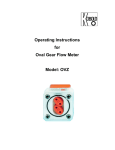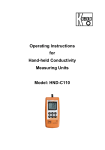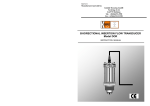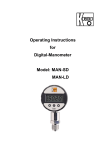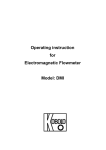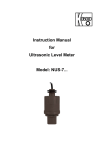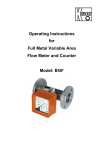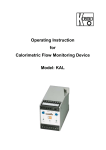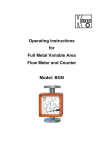Download Operating Instructions for Level Switch Tuning Fork Principal Model
Transcript
Operating Instructions for Level Switch Tuning Fork Principal Model: NWS NWS 1. Contents 1. 2. 3. 4. 5. 6. Contents ........................................................................................................ 2 Note .............................................................................................................. 3 Instrument Inspection .................................................................................... 3 Regulation Use.............................................................................................. 3 Operating Principle........................................................................................ 4 Use in Hazardous Areas (NWS-2E) .............................................................. 4 6.1 Device function .................................................................................... 4 6.2 General ................................................................................................ 5 6.3 Designation .......................................................................................... 5 6.4 Temperature resistance ....................................................................... 5 7. Mechanical Connection ................................................................................. 6 8. Electrical Connection .................................................................................... 7 8.1 NWS-...200 .......................................................................................... 7 8.2 NWS-...23/24; NWS-...2W/2H; NWS-...2E (ATEX certification) ........... 9 9. Settings ....................................................................................................... 10 9.1 Settings for NWS-...200.. ................................................................... 10 9.2 Settings for NWS-...23/24/2W/2H ...................................................... 12 9.3 Settings for NWS-...2E (ATEX certification) ....................................... 14 10. Technical Information .................................................................................. 15 11. Order Codes ............................................................................................... 17 12. Service and Maintenance ............................................................................ 17 13. Trouble Shooting ......................................................................................... 17 14. Recommended Spare Parts ........................................................................ 18 15. Disposal ...................................................................................................... 18 16. Dimensions ................................................................................................. 19 17. Declaration of Conformance ....................................................................... 21 Manufactured and sold by: Kobold Messring GmbH Nordring 22-24 D-65719 Hofheim/Germany Tel.: +49(0)6192-2990 Fax: +49(0)6192-23398 E-mail: [email protected] Internet: www.kobold.com Page 2 NWS K05/0912 NWS 2. Note Please read these operating instructions before unpacking and putting the unit into operation. Follow the instructions precisely as described herein. The devices are only to be used, maintained and serviced by persons familiar with these operating instructions and in accordance with local regulations applying to Health & Safety and prevention of accidents. When used in machines, the measuring unit should be used only when the machines fulfil the EWG-machine guidelines. 3. Instrument Inspection Instruments are inspected before shipping and sent out in perfect condition. Should damage to a device be visible, we recommend a thorough inspection of the delivery packaging. In case of damage, please inform your parcel service / forwarding agent immediately, since they are responsible for damages during transit. Scope of delivery: The standard delivery includes: • Level Switch model: NWS • Operating instructions 4. Regulation Use Kobold model NWS Liquid-Level Switches are designed to be wired as 2-wire or 3-wire switches and can be universally installed in any position in containers and piping. They can be used in many types of liquids including oils, water, paints and varnishes, sauces, milk, carbonated liquids and foamy oils. The liquid may have a maximum viscosity of 5000 cSt. At higher viscosities, the response time may increase. NWS Liquid-Level Switches are ideally suited for use in hygienic and sterile applications and designed to withstand CIP cleaning methods at temperatures up to 150 °C. Any use of the device which exceeds the manufacturers specification may invalidate its warranty. Therefore any resulting damage is not the responsibility of the manufacturer. The user assumes all risk for such usage. NWS K05/0912 Page 3 NWS 5. Operating Principle The KOBOLD liquid level switch NWS is designed as a 2 and 3-wire switch and can be universally used in vessels and pipelines. The NWS operates on the tuning fork principle in air at resonance frequency. A piezoelectric crystal is used for excitation of oscillations and for monitoring the actual oscillation frequency. When the fork is immersed in liquid, the frequency changes: this change is detected electronically and the output signal is changed. The NWS operates as a two-wire switch in series with the load. The simple electronic switch is operated by the liquid. The NWS can also be connected to a PLC through a third terminal. Special Features: The NWS has a switch status indicator with LED, which can be seen continuously through a lens in the cover. The LED flashes approximately once every second, when the NWS has switched off and goes onto a permanent light, when the NWS is switched on. The LED is a visible confirmation that the NWS is working correctly and that the condition of the wet side is correctly indicated. With a selector switch the NWS can be set either as an upper limiter or as a lower limiter. 6. Use in Hazardous Areas (NWS-2E) 6.1 Device function The intrinsically safe NAMUR oscillating fork sensor is used to detect the fill levels of combustible and non-combustible liquids. The sensor is supplied with current from a switching amplifier with an intrinsically safe output circuit in accordance with the NAMUR specification and behaves accordingly when the oscillating fork is dampened by liquid or can oscillate freely. The sensor can be used in all zones in gaseous hazardous areas. Page 4 NWS K05/0912 NWS 6.2 General The devices may be installed in zones 0, 1 and 2. The intrinsically safe circuits must be installed (by specialists) in conformance with the applicable installation requirements (certification document of installer, protected routing of the intrinsically safe circuits, etc.). The devices are constructed in accordance with protection type IP 65. If applicable, they must be protected against adverse environmental conditions. The EU model test certificates must be complied with. Any “special regulations” contained in them must be followed. The device should only be used for its intended use. The connection with the associated and/or intrinsically safe equipment must be separately checked. The sensors must be grounded to discharge accumulated electrostatic charge. At an ambient temperature area of -5 .. 70 °C the connected electrical cable may be mechanically moved. Furthermore at an ambient temperature area of - 20 .. + 70 °C the electrical cable must be mounted in a fixed and static manner. 6.3 Designation Model: NWS***2E* **** II 1 G EEx ia IIC T6 BVS 03 ATEX E 119 DMT 0158 Production-No.: SN: E999999 (consecutively numbered) 6.4 Temperature resistance The values for ambient temperatures ranging from -20 °C up to the values indicated in the following table apply to this sensor, depending on the max. temperature of the oscillating forks in the sensor: Ambient temperature Medium temperature Temperature class NWS K05/0912 70 °C 75 °C T6 70 °C 90 °C T5 Page 5 NWS 7. Mechanical Connection During installation and removal, recognised and applicable engineering practices and regulations shall be observed. When working on electrical and pneumatic plants, the special safety requirements shall be observed. The NWS switch can be installed in containers or piping by screwing it into a threaded mounting flange or other type of mounting device. The threaded connection must be sealed with Teflon (PTFE) tape. Be sure to turn the switch at the hexagonal drive; do not install the switch by turning it at the housing. After installation, the NWS-...200 can be rotated up to 330° to locate the M16 cable connection (supplied with the device) in a suitable position. If the switch is installed in a horizontal position, the tuning fork gap should be positioned vertically so that the liquid can drain from it. If the liquid being monitored is of high viscosity, the switch should be installed so that it extends the maximum distance into the container or piping in order to prevent the thick liquid from sticking and accumulating between the fork and the container or pipe wall. If the switch is installed in piping, the tuning fork gap should be positioned so that it is parallel to the pipe axis. Page 6 NWS K05/0912 NWS 8. Electrical Connection Attention! Be sure that the supply voltage of your system is the same as that specified on the device nameplate. Make sure that the electrical supply lines are de-energised when connecting the device! 8.1 NWS-...200 Series wiring with a 2-wire connection Please note: • The switch must always be operated in series with a load. • The switch must be grounded at terminal 1. • The switch draws a continuous operating current of less than 3.5 mA (even when it is "off"). For this reason, it cannot be used for loads that do not allow an “off” current (such as for gas discharge lamps). • The maximum load current for the switch is 500 mA. The user must provide suitable protective measures to ensure that this load limit is not exceeded. NWS K05/0912 Page 7 NWS Wiring diagram: 2-wire 24-240VAC/DC, series load, Imax ≤ 400mA PLC connection with 3-wire connection Please note: • An integral series resistance is used in the 3-wire circuit to generate a PLC-compliant voltage signal. • The signal can be picked up at terminal 4. • PLC programming devices or computers from various manufacturers will have different "OFF" threshold voltages. If you should have problems with this setting, please contact us for assistance. Wiring diagram: 3-wire, VS = 24 VDC, output PNP: UHIGH ~ 20 V; ULOW ~ 3.5 V; Imax ≤ 400 mA Page 8 NWS K05/0912 NWS 8.2 NWS-...23/24; NWS-...2W/2H; NWS-...2E (ATEX certification) • Make sure that the electrical supply lines are de-energised. • Connect the device using the M12x1 plug or a connection cable as shown in the wiring diagram below. • Matching connectors with different cable lengths are optionally available. • Make sure that the installation is properly performed and that the IP protection level is maintained. Wiring diagram NWS-...23/24 (24 VDC) Wiring diagram NWS-...2W/2H 2 GND (n.c.) 1 +Vs (n.o.) 3 Switch 4 Out +Vs (n.c.) GND (n.o.) 2 1 +Vs 3 Switch 4 Out GND Wiring diagram NWS-...2E.. (NAMUR, ATEX) E 2 1 3 4 -S +S (n.o.) +S (n.c.) Cable pin assignment Strand colour brown blue black NWS-...23/24 +Vs(n.o.) / GND GND / +Vs (n.c.) Switch Out Lead-/Pinnumber NWS-...2E 1 2 3 4 +S (n.o.) ground -S +S (n.c.) NWS K05/0912 NWS-...2W/2H +Vs GND Switch Out Page 9 NWS 9. Settings 9.1 Settings for NWS-...200.. 9.1.1 Signalling the operating status The NWS has an output status indicator with an LED monitor that can be viewed continuously through a lense in the cover. The LED flashes approximately once every second when the NWS is off. It is continuously illuminated when the NWS is switched on. The LED provides visual confirmation that the NWS is operating correctly and that the status of the wet side is correctly displayed. With its operating mode switch, the NWS can be set to operate as either an N/C contact or an N/O contact. 9.1.2 Operating mode selector switch The operating mode switch is positioned on the circuit board on the right about the LED. If the switch is operated as an N/C contact (upper limiter), the operating mode must be set to DRY-ON, in order to obtain the maximum fail-safe behaviour. The device completes the circuit in the dry state (empty state) so that a fault at the device or in the wiring results in a voltage drop that causes an alarm to be triggered (break circuit). Conversely, if the switch is to WET-ON, the device operates as an N/O contact (lower limiter) in fail-safe mode, in which case the fork is normally immersed in liquid. Page 10 NWS K05/0912 NWS 9.1.3 Calibration mode Each appliance is adjusted by the factory to record fluids with density 1,0 kg/l (water). It is not usually necessary to alter this pre-adjustment. In extreme situations, however, such as with very light fluids at high temperatures or highly viscous fluids, which produce a significantly extended reaction time from dry to wet, it can be advantageous to alter the pre-adjustment. In order to attain the calibration mode the Setup button must be activated and held, then the supply voltage must be switched on. After approximately 1 second the LED goes on, after 2 seconds the LED goes out, then let go of the Setup button – the appliance stays now in the main menu of the calibration mode. There is a choice of options in the main menu - Switchpoint Calibration, Hysteresis Level and LED Mode. The LED indicates the selected option: • Switchpoint Calibration: LED flashes briefly 1x, then LED 2 seconds off. • Hysteresis Level: LED flashes briefly 2x, then LED 2 seconds off. • LED Mode: LED flashes briefly 3x, then LED 2 seconds off. The option points are repeated in an infinite loop. In order to get access to an option the Setup button must be activated briefly when the LED has signalled the requested option point. Switchpoint Calibration: The "Switchpoint Calibration Mode" is signalled by: LED 1x briefly off, then LED 2 seconds on. Dip the tuning fork as far as the required switchpoint (1/2 – 2/3 of the fork length) in the medium and activate the Setup button. The calibration is made. A successful calibration is signalled by the LED flashing quickly three times. Hysteresis and LED Mode are set back to default! After calibration the switch back to the main menu takes place. Hysteresis Level: The "Hysteresis Level Mode" is signalled by: LED 2x briefly off, then LED 2 seconds on. Briefly activate the Setup button to get to the submenu. • Hysteresis Level 1(approx. 1-1.5mm): LED flashes briefly 1x, then LED 2 seconds off. • Hysteresis Level 2 (approx. 3-4.5mm, Standard): LED flashes briefly 2x, then LED 2 seconds off. • Hysteresis Level 3 (approx. 5-7.5mm): LED flashes briefly 3x, then LED 2 seconds off. NWS K05/0912 Page 11 NWS The choice of options is repeated in an infinite loop. To select an Hysteresis Level, the Setup button must be activated after the flashing of the relevant LED. Three quick flashes of the LED signal that an option has been selected, then the switch back to the main menu is made. LED Mode: The "LED Mode" is signalled by: LED briefly 3x off, then LED 2 seconds on. Briefly activate the Setup button in order to attain the option menu LED Mode. • LED Mode 1 (Standard): LED flashes briefly 1x, then LED 2 seconds off. LED shows the status of the switch output • LED Mode 2: LED flashes briefly 2x, then LED 2 seconds off. LED indicates whether the tuning fork is wetted or not The choice of options is repeated in an infinite loop. In order to select an "LED Mode" the button must be briefly activated after the relevant flashing of the LED. Three quick flashes of the LED signal that an option has been selected. When the LED Mode has been successfully selected, the switch back to the main menu is made. In order to leave the calibration mode, the appliance must be separated from the voltage supply for approx. 10 seconds 9.1.4 Test Function NWS-20 Through the pressing and holding of the setup button, independent of the state of NWS, the switching output can be temporarily switched off. During the test phase, the LED blinks rapidly. Releasing the button returns the NWS after ca. 3 sec. to the current operating condition. 9.2 Settings for NWS-...23/24/2W/2H 9.2.1 Signalling the operating status The NWS has an output status indicator with an LED monitor that can be viewed continuously through a lense in the cover. The LED flashes approximately once every second when the NWS is off. It is continuously illuminated when the NWS is switched on. The LED provides visual confirmation that the NWS is operating correctly and that the status of the wet side is correctly displayed. With its operating mode switch, the NWS can be set to operate as either an N/C contact or an N/O contact. 9.2.2 Selecting operating mode By reversing the polarity of the power supply, the switching function of the NWS...23/24 can be changed from an N/C contact to an N/O contact. In the case of the NWS-...2W/2H (WHG), the switching function cannot be changed for reasons of safety. This electronic switch opens in case of wetting, a faulty sensor or a power failure. 9.2.3 Calibration mode Each appliance is adjusted by the factory to record fluids with density 1,0 kg/l (water). It is not usually necessary to alter this pre-adjustment. In extreme Page 12 NWS K05/0912 NWS situations, however, such as with very light fluids at high temperatures or highly viscous fluids, which produce a significantly extended reaction time from dry to wet, it can be advantageous to alter the pre-adjustment. In order to attain the calibration mode the test magnet must be placed at the label marking and held, then the supply voltage must be switched on. After approximately 1 second the LED goes on, after 2 seconds the LED goes out, then remove the test magnet – the appliance stays now in the main menu of the calibration mode. There is a choice of options in the main menu - Switchpoint Calibration, Hysteresis Level and LED Mode. The LED indicates the selected option: • Switchpoint Calibration: LED flashes briefly 1x, then LED 2 seconds off. • Hysteresis Level: LED flashes briefly 2x, then LED 2 seconds off. • LED Mode: LED flashes briefly 3x, then LED 2 seconds off. The option points are repeated in an infinite loop. In order to get access to an option the test magnet must be placed briefly when the LED has signalled the requested option point. Switchpoint Calibration: The "Switchpoint Calibration Mode" is signalled by: LED 1x briefly off, then LED 2 seconds on. Dip the tuning fork as far as the required switchpoint (1/2 – 2/3 of the fork length) in the medium and activate by placing the test magnet briefly. The calibration is made. A successful calibration is signalled by the LED flashing quickly three times. Hysteresis and LED Mode are set back to default! After calibration the switch back to the main menu takes place. Hysteresis Level: The "Hysteresis Level Mode" is signalled by: LED 2x briefly off, then LED 2 seconds on. Activate by placing the test magnet briefly to get to the submenu. • Hysteresis Level 1(approx. 1-1.5mm): LED flashes briefly 1x, then LED 2 seconds off. • Hysteresis Level 2 (approx. 3-4.5mm, Standard): LED flashes briefly 2x, then LED 2 seconds off. • Hysteresis Level 3 (approx. 5-7.5mm): LED flashes briefly 3x, then LED 2 seconds off. The choice of options is repeated in an infinite loop. To select an Hysteresis Level, the test magnet must be placed briefly after the flashing of the relevant LED. Three quick flashes of the LED signal that an option has been selected, then the switch back to the main menu is made. LED Mode: The "LED Mode" is signalled by: LED briefly 3x off, then LED 2 seconds on. Briefly activate the Setup button in order to attain the option menu LED Mode. • LED Mode 1 (Standard): LED flashes briefly 1x, then LED 2 seconds off. LED shows the status of the switch output • LED Mode 2: LED flashes briefly 2x, then LED 2 seconds off. LED indicates NWS K05/0912 Page 13 NWS whether the tuning fork is wetted or not The choice of options is repeated in an infinite loop. In order to select an "LED Mode" the test magnet must be placed briefly after the relevant flashing of the LED. Three quick flashes of the LED signal that an option has been selected. When the LED Mode has been successfully selected, the switch back to the main menu is made. In order to leave the calibration mode, the appliance must be separated from the voltage supply for approx. 10 seconds 9.2.4 Test function The magnet supplied with the device can be used to switch off the electrical output of the NWS- independent of status of the tuning fork. In this case, the magnet must be placed on the location indicated on the device nameplate. After approximately 2 seconds, the NWS- switches the output off and the LED begins blinking. After the magnet is removed, the output returns after 3 seconds to its previous state. 9.3 Settings for NWS-...2E (ATEX certification) 9.3.1 Signalling the operating status Function N/C N/O Signalling LED on LED flashes quickly LED on LED flashes quickly NAMUR-output ≥ 2.1 mA ≤ 0.8 mA ≥ 2.1 mA ≤ 0.8 mA fork uncovered covered covered uncovered 9.3.2 Selecting operating mode The choice of plug connector or cable pin assignment determines whether the level switch is operated as an N/C contact or an N/O contact (see the section “Electrical connection” below). 9.3.3 Calibration mode Each NWS-2E is adjusted by the factory to record a multitude of different fluids. It is not possible to alter this pre-adjustment. Page 14 NWS K05/0912 NWS 10. Technical Information Fork: Process connection: Electronic housing: Process connections: Protection: Max. operating pressure: Max. medium temp.: Min. medium density Ambient temperature: Power supply NWS-...200..: NWS-...23/24/2W/2H..: NWS-...2E..(ATEX): Delay: Viscosity: Hysteresis: Repeatability: Weight: NWS K05/0912 stainless steel 1.4404 stainless steel 1.4404 NWS-...200: PAG, glass-fibre-reinforced cover with window, 330° rotatable all other types: stainless steel 1.4301 Pipe thread DIN EN 10226-1, NPT thread, Tri-Clamp, Pipe connection DIN 11851 (sanitary connection), Aseptic-connection DIN 11864, DRD flange, Flange B 25 PN 40 DN 2527, Flange B 50 PN 40 DN 2527, Flange ANSI B 16.5 - 1", 300 lbs, Flange ANSI B 16.5 - 2", 300 lbs plastic housing: IP 65 (NWS-...200) stainless steel housing, plug connection: IP 67 stainless steel housing, cable connection: IP 68 45 bar Flange connection: see pressure steps 130 °C (NWS-..200..) 90 °C (for all other NWS) short-time 150 °C for CIP (valid for all models NWS) 0.8 kg/L (lower on request) -20 °C...+70 °C 24...240 VDC/ AC (50/ 60 Hz); 2-wire; 24 VDC, 3-wire 24 VDC, 3-wire Isolation Switching Amplifier to IEC 60947-5-6 (Namur) necessary (for example: REL-6) 1 s wet /dry 1 s dry / wet 5000 mm2/s max. at 25 °C (influence on the response time) 4 mm vertical, 1 mm horizontal ± 1 mm at ambient temperature 0.5 kg (for R ¾ and ¾ NPT) Page 15 NWS Electrical Connection: NWS-...200...: cable connection: M 16 x 1.5 terminal: max. 1.5 mm2 (26-14 AWG) capacity: 0.4 A max. at room temp. min. switching current: 7.5 mA leakage current in off-state: < 3.5 mA constant voltage drop: ca. 6 V (2-wire connection) NWS-...23/24/2W/2H..: connector M12x1, 4-pole or 1.5 m fixed cable, 3-pole switching output: O. C. PNP or NPN (factory set), max. 300 mA, short-circuit-proof contact function: N/C or N/O adjustable by switching polarity of supply voltage (only NWS...23/24) Overload cut-off (NWS-2x): In case of thermal overload or excessive current, the unit cust off the load. The triggering of overload protection is indicated by fast blinking of the LED. NWS-...2E.. (ATEX): connector M12x1, 4-pole or 1.5 m cable 2-wire NAMUR output N/C or N/O selectable N/C: ≥ 2.1 mA discovered ≤ 0.8 mA covered N/O: ≤ 0.8 mA discovered ≥ 2.1 mA covered Page 16 NWS K05/0912 NWS 11. Order Codes Example: NWS-R20 20 0 0000 Connection R ¾ male thread R 1 male thread ¾ NPT male thread 1 NPT male thread DIN-flange DN 25 DIN-flange DN 50 1“ ANSI-flange 2“ ANSI-flange Tri-Clamp DN 40 Tri-Clamp DN 50 Sanitary DN 40 (DIN 11851) Sanitary DN 50 (DIN 11851) Aseptic connection DN 50 (DIN 11864) DRD Ø 125 mm flange Model NWS-R20... NWS-R25...* NWS-N20... NSW-N25...* NWS-F25... NWS-F50...* NWS-A25... NWS-A50...* NWS-T40... NWS-T50... NWS-L40... NWS-L50... Special connection NWS-YYY... NWS-H50... NWS-D1Z... Electrical connection Plastic housing 200 = 24...240 VAC/DC cable gland/terminal connect. St. steel housing/plug connect. 23S = 24 VDC, PNP, plug M12x1 24S = 24 VDC, NPN, plug M12x1 2WS*** = 24 VDC, WHG, PNP, plug M12x1 2HS*** = 24 VDC, WHG, NPN, plug M12x1 2ES = ATEX-approval, plug M12x1 St. Steel housing/cable connect. 23F = 24 VDC, PNP, 1.5 m cable 24F = 24 VDC, NPN, 1.5 m cable 2WF*** = 24 VDC, WHG, PNP, 1.5 m cable 2HF*** = 24 VDC, WHG, NPN, 1.5 m cable 2EF = ATEX-approval, 1.5 m cable Sensor version 0060 = 60 mm (only for NWS-T / NWS-L / NWS-H) 0070 = 70 mm standard version, short (not for NWS-T / NWS-L) 0117** = 117 mm extended 0300** = 300 mm sensor 0500**= 500 mm sensor 1000** = 1000 mm sensor XXXX** = please specify special length 4-position in mm (max. 3000 mm) **only models marked with *are available with sensors in extended version. ***WHG-approval in preparation. 12. Service and Maintenance The functional behaviour of these devices is stable, even over long periods or time. Regular adjustments or similar procedures are not required. No maintenance of any type is required. In the event that device faults are noted, this device should be immediately removed from service. The device contains no user-serviceable parts. Return the device to the manufacturer for examination. 13. Trouble Shooting Devices that are operated in hazardous areas must not be modified in any way. Repairs must be performed by trained, qualified service personnel only. Defective devices should normally be returned to the manufacturer for examination. NWS K05/0912 Page 17 NWS 14. Recommended Spare Parts There are no recommended spare parts. If the device becomes defective, it usually means that there is a fault in the device electronics that must be diagnosed and repaired. In this case, we recommend that the device be returned to the manufacturer for servicing. 15. Disposal Disposal of packaging and used parts shall be done in conformance with the regulations of the country in which the device is installed. Page 18 NWS K05/0912 NWS 16. Dimensions NWS-...200 24...VAC/DC Plastic housing NWS-...23S/24S NWS-...2WS/2HS 24 VDC Plug connection NWS-...23F/24F NWS-...2WF/2HF 24 VDC Terminal connection Ø 40 65 70 Ø 40 NWS-...2ES ATEX Plug connection NWS K05/0912 NWS-...2EF ATEX Cable connection Page 19 NWS NWS-R20/N20 (Standard, short) NWS-R25/N25 NWSN25...0117 (Standard, long) NWS-F../NWS-A.. Flange version DN 25 /PN 40 DN 50 / PN 40 ANSI 1“ 300 lbs ANSI 2“ 300 lbs L2 18 20 17,5 22,4 NWS-L.. Sanitary connection (DIN 11851) Page 20 NWS-T.. Tri-clamp L3 approx. 47 approx. 95 approx. 41 approx. 92 NWS-H.. Aseptic connection (DIN 11864) NWS K05/0912 NWS 17. Declaration of Conformance We, KOBOLD Messring GmbH, Hofheim-Ts, Germany, declare under our sole responsibility that the product: Level Switch model: NWS -.. to which this declaration relates is in conformity with the standards noted below: EN 61010-1 2002 EN 61326-A2 2006 Additional for model NWS-***2E* **** EN 50014: 1997 + A1 – A2 EN 50020: 1994 EN 50284: 1999 Also the following EEC guidelines are fulfilled: 2004/108/ EC (Electromagnetic compatibility) 2006/95/EC (Low voltage guideline) 94/9/ECEquipment and Protective systems intended for use in a potentially Explosive Atmospheres (ATEX 100a) Quality Management Production Certificate number: BVS 09 ATEX ZQS/E110 Notified body: DEKRA Exam GmbH Identification number: 0158 Hofheim, 30. Sep. 2010 H. Peters General Manager NWS K05/0912 M. Wenzel Proxy Holder Page 21 NWS Page 22 NWS K05/0912 NWS NWS K05/0912 Page 23 NWS Page 24 NWS K05/0912

























